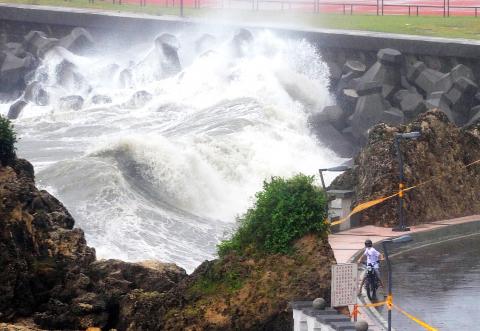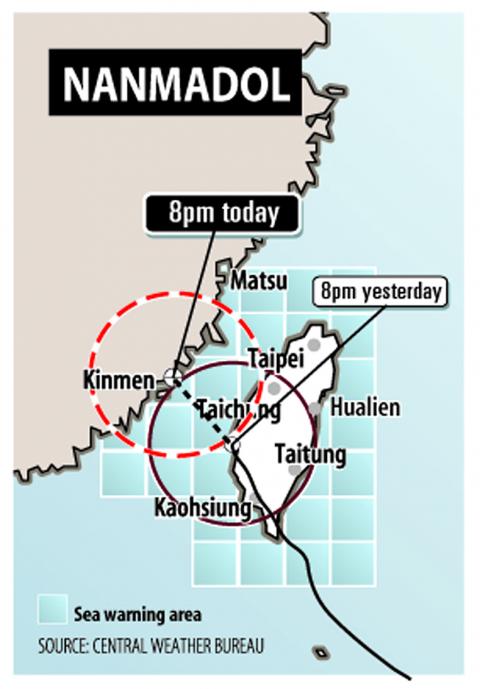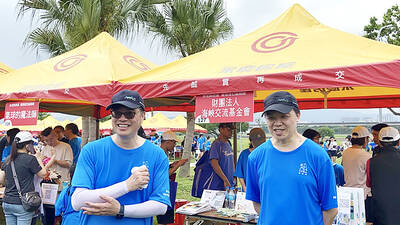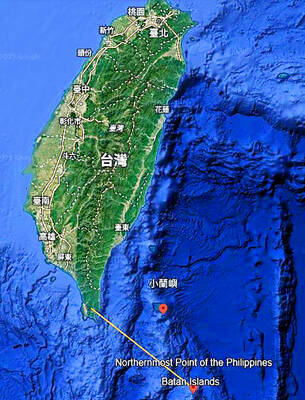Torrential rain brought by Typhoon Nanmadol caused severe flooding in Pingtung County yesterday, damaging more than 600 houses in Hengchun Township (恆春) and claiming one life before heading for China.
Aside from Hengchun, flooding was also reported in Pingtung’s Linbian (林邊), Donggang (東港), Jiadong (佳冬) and Wanluan (萬巒) townships. Two houses in Manjhou Township (滿州) were damaged by a mudslide, although no casualties were reported. The county was also forced to shut down eight bridges because of rising river levels.
A 36-year-old man in Jhongli (中壢), Taoyuan County, was killed by flying glass while he was riding his scooter after a window was blown out by a strong gust of wind.

Photo: Huang Chih-yuan, Taipei Times
More than 300 people were trapped by landslides in Wutai Village (霧台), Pingtung County, the Central Emergency Operation Center said, adding that all villagers were safe.
More than 50,000 troops were deployed yesterday to evacuate residents in dangerous areas.
The Soil and Water Conservation Bureau said that by 7pm, 442 mudslide-prone rivers in eastern and southern regions, as well as on the Hengchun Peninsula, were on yellow alert, while 12 in Pingtung County were on red alert.

Graphic: TT
The Council of Agriculture (COA) said local governments in those areas should warn residents of the risks and advise them on an evacuation plan.
Air traffic was disrupted by the storm, with about 200 domestic and international flights canceled or delayed because of weather.
The Central Weather Bureau said the typhoon made landfall at 4:20am yesterday at Dawu (大武), Taitung County.
The typhoon had been reduced to a tropical storm by 8am as its structure was damaged after it made landfall. It then moved through Tainan to the Taiwan Strait at about 1pm.
Bureau forecaster Chen Yi--liang (陳怡良) said the storm was expected to move slowly westward toward China and would lose strength along the way.
However, the storm could also linger in the Taiwan Strait for some time, he said.
The bureau could lift the land warning for Taiwan proper this afternoon if the storm maintains its current course and weakens at a pace faster than expected.
While the bureau had lowered the rainfall estimates for eastern and northeastern regions as the typhoon moved westward, Chen said it continued to issue torrential rain alerts for residents in southeastern regions, the Hengchun Peninsula as well as in mountainous areas in the south.
The 10 locations that had -registered the highest accumulated -rainfall were all in Pingtung County, the bureau said.
As of 5:30pm, the center of Nanmadol was located 30km off the southeast coast of Penghu. It was moving northwest at 7kph.
As wind and rain eased in northern and eastern Taiwan, the -Directorate-General of Highways (DGH) reopened the Suhwa Highway at 7am yesterday, which had been closed since 6pm on Sunday.
The South Link Highway became accessible again at 5:30pm.
The section between Dayuling (大禹嶺) and Taroko on the Central Cross-Island Highway was also reopened at 2pm.
The Taiwan Railway Administration said services on the South Link Line would resume first thing this morning. Train services between Hualien and Taitung and along the North Link Line resumed yesterday.
Meanwhile, the COA said agricultural losses from the typhoon were estimated at NT$10 million (US$345,000), with bananas hit the hardest. The torrential rain squalls and gusty winds brought by the storm since Sunday caused heavy damage to crops in Hualien, as well as in Pingtung and Taitung counties, it said. As of 9am yesterday, nearly 374 hectares of farmland had been affected, the council said.
The heaviest damage was to bananas, which sustained losses of more than NT$3 million, the COA said. Banana farms in Pingtung County were the worst hit, it said.Other crops damaged by the storm included sugar apples, watermelons, wax apples and vegetables, it said.
The heavy rainfall nevertheless brought temporary relief from the threat of drought, Taiwan Water Corp (TWC, 台灣自來水) said. The water storage level at the Tsengwen Reservoir, one of the major reservoirs in the south, was just 48 percent before the storm hit as a result of scant precipitation since the spring. The rate had recovered to near full capacity as of yesterday, TWC said.
With Taiwan experiencing the worst drought in eight years, Tsengwen Reservoir was the first reservoir this year to reach full capacity, making rice farmers happy that there would be enough water to plant their first crop next year, TWC said.
Meanwhile, Keelung, which had been on the verge of implementing phase-one water rationing before the storm hit, also received welcome relief from dry conditions. The Hsinshan Reservoir, Keelung’s main source of water, has continued to rise.
By nightfall yesterday, water reserves at the Hsinshan Reservoir were expected to climb to more than 6.1 million tonnes, the threshold at which phase-one rationing will be lifted, the water company said.
Under phase-one water rationing — the lightest rationing measure — water pressure is reduced from 11pm to 5am and water for irrigation is also restricted.
Although the Shihmen Reservoir in Taoyuan County — one of the two major reservoirs supplying water to the Greater Taipei area — also benefited from rainfall brought by Nanmadol over the past two days, the volume still fell short of comfortable levels.
Additional reporting by AFP and CNA

SECURITY: As China is ‘reshaping’ Hong Kong’s population, Taiwan must raise the eligibility threshold for applications from Hong Kongers, Chiu Chui-cheng said When Hong Kong and Macau citizens apply for residency in Taiwan, it would be under a new category that includes a “national security observation period,” Mainland Affairs Council (MAC) Minister Chiu Chui-cheng (邱垂正) said yesterday. President William Lai (賴清德) on March 13 announced 17 strategies to counter China’s aggression toward Taiwan, including incorporating national security considerations into the review process for residency applications from Hong Kong and Macau citizens. The situation in Hong Kong is constantly changing, Chiu said to media yesterday on the sidelines of the Taipei Technology Run hosted by the Taipei Neihu Technology Park Development Association. With

CARROT AND STICK: While unrelenting in its military threats, China attracted nearly 40,000 Taiwanese to over 400 business events last year Nearly 40,000 Taiwanese last year joined industry events in China, such as conferences and trade fairs, supported by the Chinese government, a study showed yesterday, as Beijing ramps up a charm offensive toward Taipei alongside military pressure. China has long taken a carrot-and-stick approach to Taiwan, threatening it with the prospect of military action while reaching out to those it believes are amenable to Beijing’s point of view. Taiwanese security officials are wary of what they see as Beijing’s influence campaigns to sway public opinion after Taipei and Beijing gradually resumed travel links halted by the COVID-19 pandemic, but the scale of

A US Marine Corps regiment equipped with Naval Strike Missiles (NSM) is set to participate in the upcoming Balikatan 25 exercise in the Luzon Strait, marking the system’s first-ever deployment in the Philippines. US and Philippine officials have separately confirmed that the Navy Marine Expeditionary Ship Interdiction System (NMESIS) — the mobile launch platform for the Naval Strike Missile — would take part in the joint exercise. The missiles are being deployed to “a strategic first island chain chokepoint” in the waters between Taiwan proper and the Philippines, US-based Naval News reported. “The Luzon Strait and Bashi Channel represent a critical access

Pope Francis is be laid to rest on Saturday after lying in state for three days in St Peter’s Basilica, where the faithful are expected to flock to pay their respects to history’s first Latin American pontiff. The cardinals met yesterday in the Vatican’s synod hall to chart the next steps before a conclave begins to choose Francis’ successor, as condolences poured in from around the world. According to current norms, the conclave must begin between May 5 and 10. The cardinals set the funeral for Saturday at 10am in St Peter’s Square, to be celebrated by the dean of the College